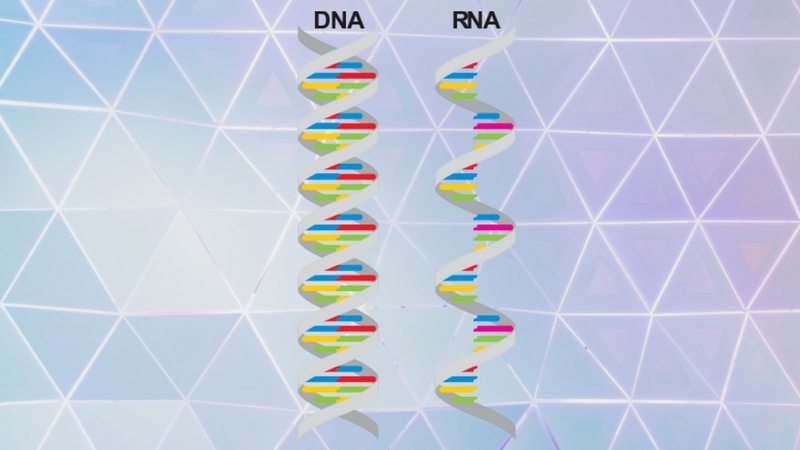Messenger RNA
Episode #7 of the course The molecular building blocks of life by Dr. Bill Thomas
In previous lessons, we’ve looked at how nucleotides form the building blocks of DNA and provide the basis for the genetic code used by all life on Earth. We’ve also seen that genes are nothing more or less than the blueprints for building proteins, the molecular machines responsible for carrying out biological functions. In this lesson, we’ll explore the process of building a protein according to the genetic code. The key building block at each stage of this process is RNA, which can take multiple forms. Let’s begin with messenger RNA.
What’s the Difference between DNA and RNA?
Like DNA, RNA (short for ribonucleic acid) is made from a long chain of nucleotides; however, there are important differences in the nucleotides used. The carbohydrate used in RNA nucleotides (ribose) has one more oxygen than the carbohydrate used in DNA nucleotides (deoxyribose). Also, RNA uses a slightly different “alphabet” than DNA, replacing T (thymine) with U (uracil) in the genetic code. Another key difference between DNA and RNA is that RNA is usually made up of a single strand, while DNA is composed of two strands held together by mutual attraction. While DNA has only one function in the cell, its sister molecule RNA is extremely versatile and fills a number of vital roles. Messenger RNA, or mRNA, has one of these important roles.
Copying the Blueprint
The first step in building a protein to genetic specifications is to make an RNA copy of the gene. Using one strand of a DNA molecule as a template, an RNA molecule is assembled one nucleotide at a time (a process carried out by proteins) until all the information needed to make a protein has been copied. This copy is called a messenger RNA, or mRNA, because it carries the necessary information to the protein-making machinery of the cell. The process of copying a gene into mRNA is called transcription.
What’s Next?
In bacteria, a completed messenger RNA, or mRNA, is immediately ready to be used in protein production. In fact, the process of making a protein from an mRNA blueprint typically begins even before the process of assembling the mRNA molecule is complete. However, in more complex organisms such as animals, plants and fungi, or even some single-celled organisms like amoebae or algae, DNA is stored in a specialized compartment called the nucleus.
In these organisms, after a gene has been transcribed into messenger RNA, the mRNA molecule is packaged up in proteins responsible for protecting it and transporting it outside of the nucleus to the protein-making machinery of the cell, ribosome (which we’ll talk about in the next lesson). Strangely enough, some proteins must be transported back into the nucleus after they are made, as they perform important functions inside this compartment. Because this process seems rather complicated, it might be tempting to ask why it is necessary to copy a gene into mRNA before making a protein. Why not translate the genetic code directly from the DNA itself?
Why mRNA?
Because proteins are not assembled directly from genes, but rather from RNA copies of a gene, the amount of a protein produced in a cell can be adjusted according what the cell needs. If a particular protein is not needed in a cell at a particular time, messenger RNAs of that gene will not be transcribed.
On the other hand, when more of a protein is needed, many copies of the gene can be made, making it possible for more of the protein to be produced. An example of this type of gene regulation can be observed in bacteria that consume the sugar lactose. When lactose is scarce or when their preferred sugar, glucose, is available, the gene that codes for a lactose-digesting protein is not transcribed. However, when only lactose is available, many copies of the gene are transcribed so the protein can be produced in sufficient quantities.
Messenger RNA is not the only RNA molecule involved in protein production. In the next lesson, we will see that RNA is an important part of the protein-making machinery itself!
Recommended book
Atomic Evidence: Seeing the Molecular Basis of Life by David S. Goodsell
Share with friends

